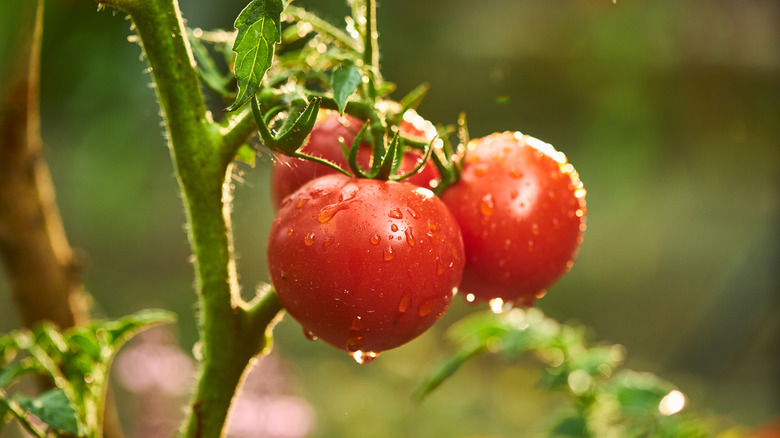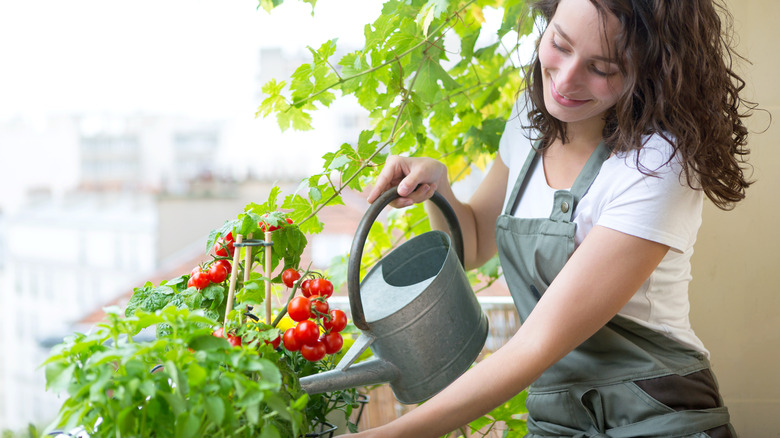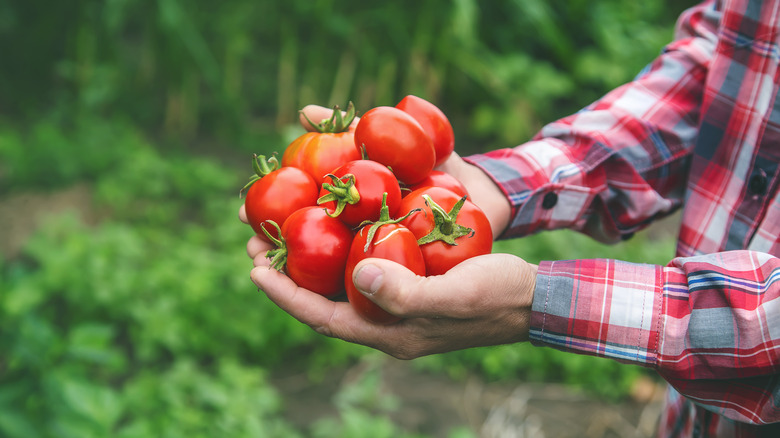Everything You Need To Know About Watering Your Tomatoes For A Healthy Yield
The only thing better than an organic, homegrown tomato on a hot summer day is a whole bushel of organic homegrown tomatoes on a hot summer day. Tomatoes are popular plants to grow for beginner gardeners. They're relatively fast-growing and produce beautiful fruits that can be used in a wide variety of recipes — or eaten raw! With the right watering technique, your kitchen counter can start to look like a prolific produce aisle. The key to yielding a bountiful tomato harvest is to water your plants consistently and deeply, maintaining a regular watering schedule while also paying attention to rain and other aspects of the environment.
Keeping up with frequent watering may seem like a no-brainer to anyone with half a green thumb, but how can you determine how often your plants want to be watered? Learn more about how to listen to what your tomato plants are telling you, the best method for watering your plants, and why any healthy yield of fruits starts at the roots.
Water with consistency and quality
The trickiest thing about tomato plants is that they'll often display many of the same problems when they're overwatered as they do when they're underwatered. Some common symptoms of both include droopy, yellow or brown leaves, failure to bloom, and squishy or spotted fruit. However, if you notice crispy and curled green leaves, dry, compact soil, and slow growth, your tomato plant is likely desperate for more water.
To avoid neglecting or flooding your plant, it's best to create a consistent watering schedule. Most tomato varieties will thrive when they're watered every two to three days, but individual strains may vary. To help you remember when to water, try coming up with a schedule that's easy to remember, like Mondays, Wednesdays, and Fridays. Know when to water your plants, but also when not to water. For example, if stormy rain clouds have brooded over your garden for days, you probably don't need to dump more water on your already drenched plants, but if sunny temperatures soar, you may need to water outdoor plants every day.
Consistent watering is crucial, but the technique you use to water your tomato plants is just as important. Every week, your tomato plant should receive a total of around 2 gallons of water per square foot. Whenever you water your plants, water deeply and evenly soak the root bed. Tomatoes like some humidity, but you should avoid misting the leaves of the plant, as this can create problems with fungi.
Provide all the necessities to thrive
Another reason you should always water deeply around the plant is that this will help fertilizer and other vital nutrients seep into the soil and encourage root growth. A healthy tomato yield starts at the roots, so make sure to reserve plenty of space between tomato plants and always plant in rich, nutrient-dense soil. It takes a lot of nutrients for any plant to produce fruits, but tomato plants are "heavy feeders" that require a lot of phosphorous, nitrogen, and potassium in their soil, with micronutrients like calcium and magnesium. To ensure that your tomato plants are getting the nutrients they need to produce a bountiful yield, only fertilize the plants about a month after planting them and again before they begin to fruit.
Besides good watering habits, other ways to increase your tomato yield include plucking dead leaves, removing suckers that grow at branch axils, and pruning the plant when needed. Growing companion plants like onions, garlic, basil, marigolds, and lavender can help to deter pests, reduce disease, and attract pollinators to your tomato plants, improving your yield even more. Once you've gathered a fine crop of ripe tomatoes, store them stem-side down in a cool, dark place and eat them as soon as you can.


